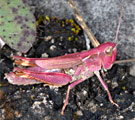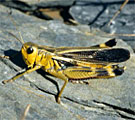Chorthopodisma cobellii (Krauss, 1883)
![Chorthopodisma cobellii: Male (Monte Pasubio, August 2014) [N] Chorthopodisma cobellii: Male (Monte Pasubio, August 2014) [N]](thumbs/catantopidae/cobellii_m2014.jpg)
![Chorthopodisma cobellii: Male (Monte Pasubio, August 2014) [N] Chorthopodisma cobellii: Male (Monte Pasubio, August 2014) [N]](thumbs/catantopidae/cobellii_2m2014.jpg)
![Chorthopodisma cobellii: Male (Monte Pasubio, August 2014) [N] Chorthopodisma cobellii: Male (Monte Pasubio, August 2014) [N]](thumbs/catantopidae/cobellii_3m2014.jpg)
![Chorthopodisma cobellii: Male (Monte Pasubio, August 2014) [N] Chorthopodisma cobellii: Male (Monte Pasubio, August 2014) [N]](thumbs/catantopidae/cobellii_4m2014.jpg)
![Chorthopodisma cobellii: Male (Monte Pasubio, August 2014) [N] Chorthopodisma cobellii: Male (Monte Pasubio, August 2014) [N]](thumbs/catantopidae/cobellii_5m2014.jpg)
![Chorthopodisma cobellii: Female (Monte Pasubio, August 2014) [N] Chorthopodisma cobellii: Female (Monte Pasubio, August 2014) [N]](thumbs/catantopidae/cobellii_w2014.jpg)
![Chorthopodisma cobellii: Female (Monte Pasubio, August 2014) [N] Chorthopodisma cobellii: Female (Monte Pasubio, August 2014) [N]](thumbs/catantopidae/cobellii_2w2014.jpg)
![Chorthopodisma cobellii: Female (Monte Pasubio, August 2014) [N] Chorthopodisma cobellii: Female (Monte Pasubio, August 2014) [N]](thumbs/catantopidae/cobellii_3w2014.jpg)
![Chorthopodisma cobellii: Female (Monte Pasubio, August 2014) [N] Chorthopodisma cobellii: Female (Monte Pasubio, August 2014) [N]](thumbs/catantopidae/cobellii_4w2014.jpg)
![Chorthopodisma cobellii: Female (Monte Pasubio, August 2014) [N] Chorthopodisma cobellii: Female (Monte Pasubio, August 2014) [N]](thumbs/catantopidae/cobellii_5w2014.jpg)
![Chorthopodisma cobellii: Female (Monte Pasubio, August 2014) [N] Chorthopodisma cobellii: Female (Monte Pasubio, August 2014) [N]](thumbs/catantopidae/cobellii_6w2014.jpg)
![Chorthopodisma cobellii: Female (Monte Pasubio, August 2014) [N] Chorthopodisma cobellii: Female (Monte Pasubio, August 2014) [N]](thumbs/catantopidae/cobellii_7w2014.jpg)
![Chorthopodisma cobellii: Female (Monte Pasubio, August 2014) [N] Chorthopodisma cobellii: Female (Monte Pasubio, August 2014) [N]](thumbs/catantopidae/cobellii_8w2014.jpg)
![Chorthopodisma cobellii: Female (Monte Pasubio, August 2014) [N] Chorthopodisma cobellii: Female (Monte Pasubio, August 2014) [N]](thumbs/catantopidae/cobellii_9w2014.jpg)
![Chorthopodisma cobellii: Female (Monte Pasubio, August 2014) [N] Chorthopodisma cobellii: Female (Monte Pasubio, August 2014) [N]](thumbs/catantopidae/cobellii_10w2014.jpg)
![Chorthopodisma cobellii: Female (Monte Pasubio, August 2014) [N] Chorthopodisma cobellii: Female (Monte Pasubio, August 2014) [N]](thumbs/catantopidae/cobellii_11w2014.jpg)
![Chorthopodisma cobellii: Habitat (Monte Pasubio, August 2014) [N] Chorthopodisma cobellii: Habitat (Monte Pasubio, August 2014) [N]](thumbs/catantopidae/cobellii_h2014.jpg)
![Chorthopodisma cobellii: Habitat (Monte Pasubio, August 2014) [N] Chorthopodisma cobellii: Habitat (Monte Pasubio, August 2014) [N]](thumbs/catantopidae/cobellii_h22014.jpg)
Habitat:
Chorthopodisma cobellii inhabits similar sites as P. baldensis: herb-rich pastures and grasslands from about 1400m asl.
Remarks:
Chorthopodisma cobellii is endemic to Monte Pasubio in Northern Italy. Only the deep valley of river Adige is located between its occurrence and that of P. baldensis. There can not be any doubt that both species evolved from a common ancestor and had been separated by different reguges in last glacial period (ice-free summits). After that there was no further spreading.
Hints on determination:
Chorthopodisma cobellii differs from the closely related Pseudoprumna baldensis in the reduction of the tympanal organ and especially as female also in the caudal reduction of the black stripe coming from the eyes.


